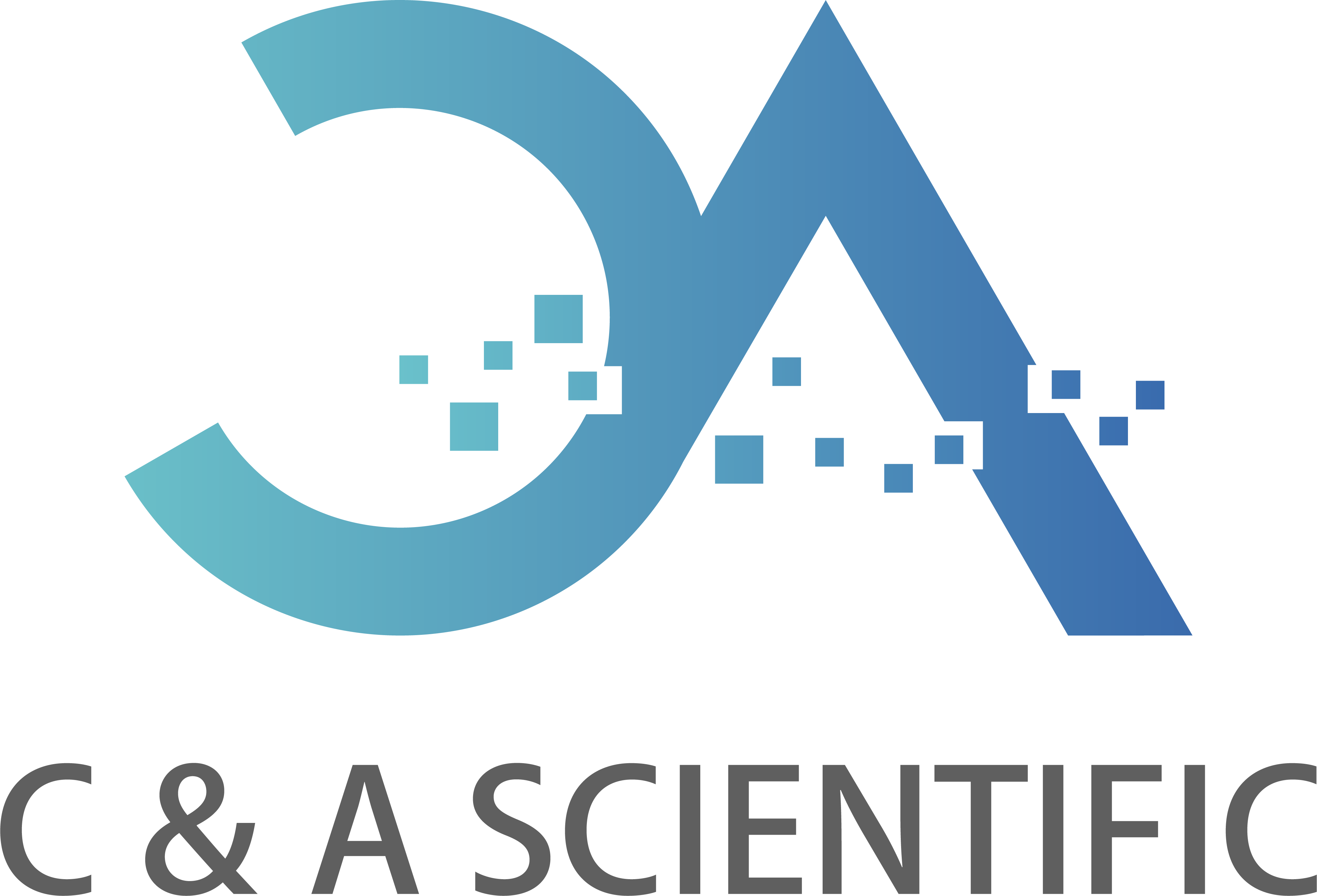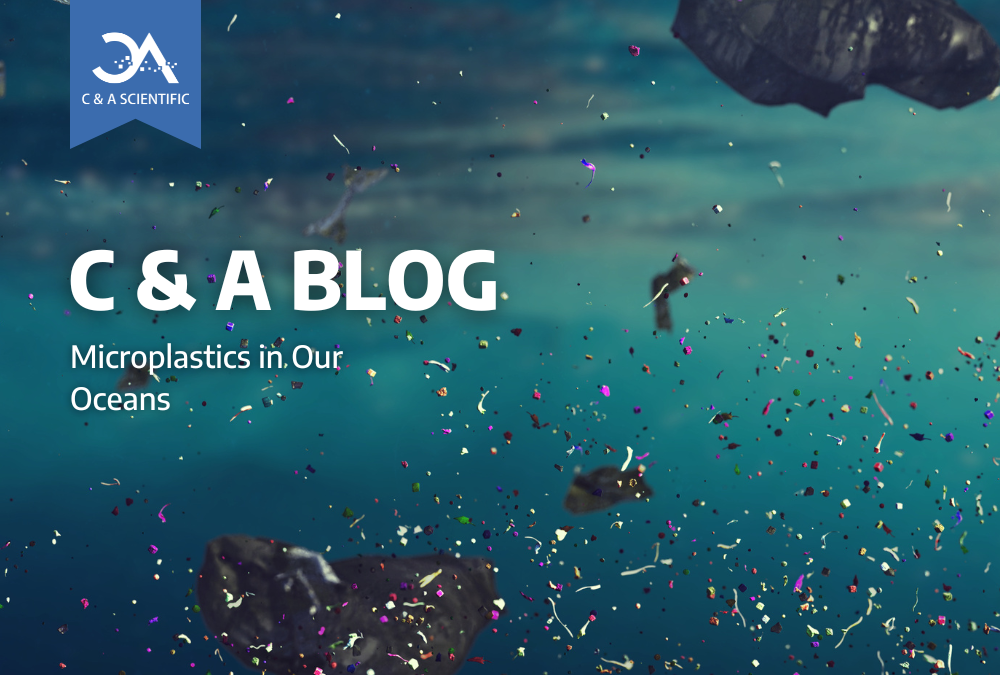
Did you know that the average person consumes over 5 grams of microplastics weekly?
Microplastics are a severe environmental and health concern. Today, C & A Scientific will explain why we should be concerned about the number of microplastics in our oceans.
TABLE OF CONTENTS
- What are Microplastics?
- Lifespan of Microplastics
- What Causes Microplastics?
- Why Should We Be Concerned?
- Microplastics and Marine Life
- Health Risks Associated with Microplastics
- Ways to Reduce Microplastics
- Resources
- C & A Scientific’s Mission
What are Microplastics?
Microplastics are tiny plastic fragments that are less than 5mm in length. When more significant pieces of plastic get moved around in the ocean and exposed to the sun, they break into smaller pieces. However, some plastic is naturally small such as microbeads.
Microbeads are less than one millimeter wide and are in various products, such as face wash, toothpaste, and laundry detergent. The polyethylene in microbeads acts as an exfoliant and sustains shelf life.
Polyethylene is the most common type of plastic used mainly for packaging and plastic bags. Although BPA-free and considered safe, polyethylene terephthalate (PET) plastic poses various health concerns, such as issues with:
- Reproduction
- Balance
- Low energy
- Stress levels
Polyethylene is the type of plastic in most disposable water bottles.
Are you interested in learning more about the impact of forever chemicals? Read our blog, How Forever Chemicals are Causing the Health Crisis of the Century, to learn more about which products pose health risks today.
Lifespan of Microplastics
The threat of microplastics on our planet is severe because microplastics never really go away. Microplastics do not biodegrade and can be around for hundreds or thousands of years. As they multiply and accumulate in our oceans, they continue to exist in our food and water supply.
What Causes Microplastics?
Shipping waste, fishing products, and trash link to microplastics. However, these are not the only sources of microplastics. Microfibers produced in carpets and clothing make up most of the plastic in the ocean.
According to a study completed by the International Union for Conservation of Nature, plastic from the ocean mainly comes from the following:
- Tires
- Dust
- Textiles
- Plastic pellets
- Road markings
- Hygiene products
- Marine coatings
Synthetic textiles and tires make up the majority of microplastics in the ocean. Around 28% of microplastic found in our oceans come from tires.

Over 39% of dust found in homes contains microplastics. These microfibers get into our environment through the home laundry process, and the waste processed during treatment is too small to be caught and removed.
Wastewater treatment plants effectively remove a significant amount of larger plastic particles; however, the sludge from wastewater plants often functions as agricultural compost. This use means that crops grown in the United States also contain microplastics.
Microplastics are in the air as well as the water. When the ocean moves, it traps the air in tiny bubbles.
Small microplastic particles move into the air as the bubbles break at the ocean’s surface. These particles can also pick up contaminants in the surrounding environment, such as phthalates, flame retardants, and heavy metals.
Why Should We Be Concerned?
Microplastics are in our air, crops, animals, and water supply. Because of this chain reaction, we constantly consume microplastics with little knowledge of how these chemicals disrupt our bodies. First, it is important to look at how microplastics affect marine life.
Microplastics and Marine Life
Microplastics slow the growth and reproduction of marine life. Polystyrene microplastics have proved to reduce the reproductive capacity of fish.
Dr. Susanne Brander of Oregon State University explains the impact microplastics have on marine life,
“but they are also trophically transferred, meaning that they are ingested by smaller organisms that are then fed upon as prey items by forage fish or larger predators. The ultimate result is that these items can end up in seafood on our dinner plates.”
When fish ingest microplastics, they expose themselves to chemicals such as polyethylene. Chemicals in plastic can have harsh impacts on fish and even alter their gene expression.
Some other side effects can include damage and disruption to their:
- DNA
- Intestines
- Reproductive organs
- Tissues
- Oxidative systems
- Life span
Even in larger animals, like turtles, microplastics can impact reproduction. The sex of marine turtle eggs is typically skewed towards females if the sand is warmer at incubation. Since microplastics in sand raise the overall temperature, many turtle populations now see a rise in female births over male births.

Health Risks Associated with Microplastics
Of the 3,000 chemical additives plastic is treated with, 98 are toxic, while 15 disrupt the endocrine system. The endocrine system is responsible for creating and regulating hormones for your brain development and mood and maintaining the functions of your reproductive system and metabolism.
Endocrine-disrupting chemicals have been a leading cause of intellectual disabilities, cancer, and brain damage in humans over the last 20 years.
Although more research will help to understand the full implications and effects microplastics have on humans, the possible effects shown are unsettling.
These effects include disruptions to the following:
- Immunity
- Reproductive system
- Nervous system
- Metabolism
- Cells and tissues
Microplastics act as toxins in the human body through inflammatory lesions and oxidative stress. It has been shown to affect humans’ endocrine systems immediately and has a carcinogenic impact in the long term.
Ways to Reduce Microplastics
Although microplastics are everywhere, there are steps you can take to reduce the amount of microplastic you consume and expose yourself to. Follow these seven ways to reduce your use of plastic today.
1. Stop Eating Shellfish
- Shellfish at the bottom of the ocean ingest microplastics, which you then consume. Stop eating shellfish, such as shrimp, oysters, and scallops.
2. Avoid Microwaving Plastic Containers
- Plastic will leak into your food, even if the container says it’s microwave safe.
3. Throw Out Cosmetics with Plastic
- Microbeads are in laundry detergent, face wash, and other personal hygiene items. Choose products that don’t contain microbeads, nylon, or any variation of polyethylene.
4. Shop Organic Clothing
- Purchase clothing made from more sustainable materials. Cotton and wool are natural fibers that release fewer microfibers into the air and water. Polyester and other synthetic fabrics are harsh on the environment.
5. Refine Your Laundry Process
- Use less water and air dry your clothes to reduce the number of microfibers in the air.
6. Stop Using Single-Use Plastic
- Don’t use plastic water bottles, bags, or straws. Instead, choose items that are reusable and eco-friendly!
7. Dust Frequently
- Vacuum, dust, and change your air filters to improve the air quality in your home.

To learn more about the harmful effects of microplastics and ways to reduce your use, visit the resources below!
Resources
Allen, Jennifer. “Microplastics: The ‘Big Little Problem’ Plaguing Oceans.” Coastal Review, 23 July 2021, https://coastalreview.org/2021/07/microplastics-the-big-little-problem-plaguing-our-oceans/
Bhuyan, Md. Simul. “Effects of Microplastics on Fish and in Human Health.” Frontiers, Frontiers, 28 Feb. 2022, https://www.frontiersin.org/articles/10.3389/fenvs.2022.827289/full#:~:text=Humans%20may%20experience%20oxidative%20stress,and%20human%20are%20still%20unknown.
Boucher, Julien, and Damien Friot. “Primary Microplastics in the Oceans: a Global Evaluation of Sources.” International Union for Conservation of Nature, https://portals.iucn.org/library/sites/library/files/documents/2017-002-En.pdf
US Department of Commerce, National Oceanic and Atmospheric Administration. “A Guide to Plastic in the Ocean.” NOAA’s National Ocean Service, 20 Sept. 2018, https://oceanservice.noaa.gov/hazards/marinedebris/plastics-in-the-ocean.html#:~:text=Unlike%20some%20other%20kinds%20of,into%20tiny%20pieces%2C%20called%20microplastics.
C & A Scientific’s Mission
C & A Scientific aims to improve the health and minds of people worldwide. Positive change starts with caring for our planet and ensuring the best practices to maintain a healthy lifestyle. Limiting our use of microplastics can significantly impact our immunity, metabolism, and nervous system.
Read more on maintaining a healthy lifestyle on our blog, Break Habits- Get Healthy with 3 New Year’s Tips, today!
Check out our About Us section to learn more about how we work to change the world positively.
C & A Scientific is a dedicated leader in improving the health and minds of people worldwide. We supply over 700 medical and STEM-inspired products to distributors and retailers seeking sensational customer service. Learn more about us and our story here.

